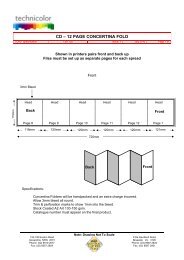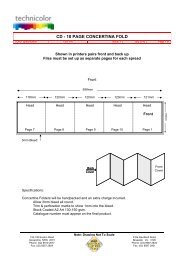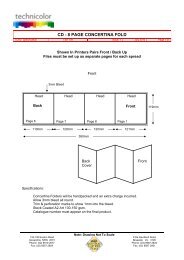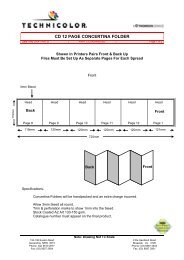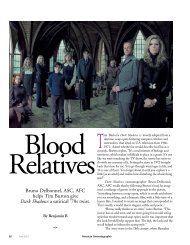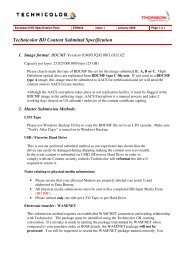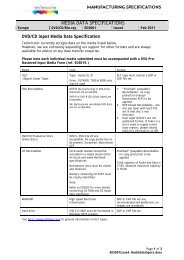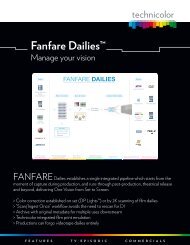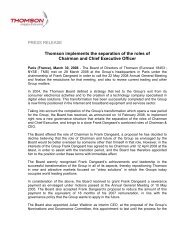FORM 20-F THOMSON multimedia - Technicolor
FORM 20-F THOMSON multimedia - Technicolor
FORM 20-F THOMSON multimedia - Technicolor
You also want an ePaper? Increase the reach of your titles
YUMPU automatically turns print PDFs into web optimized ePapers that Google loves.
and 10% in 1999. The acquisition of <strong>Technicolor</strong> did not have a significant impact on our geographic<br />
breakdown of net sales.<br />
Effect of exchange rate fluctuations<br />
We estimate that the impact of translating revenues of operating entities that are denominated in<br />
currencies other than euro into euro had a positive impact of 0 <strong>20</strong>4 million in 1999, 0 136 million in<br />
<strong>20</strong>00 and 0 182 million in <strong>20</strong>01 on our net sales as expressed in euro. We believe that the impact of<br />
exchange rate fluctuations on our net income is limited due to certain natural hedges discussed in<br />
Item 11: ‘‘Quantitative and Qualitative Disclosures about Market Risk — Impact of Exchange Rate<br />
and Interest Rate Fluctuations’’. Please see this section for more information on the impact of<br />
exchange rate fluctuations on our net sales and net income and details on our hedging policies.<br />
Use of estimates<br />
The preparation of our consolidated financial statements in conformity with generally accepted<br />
accounting principles in France requires management to make estimates and assumptions that affect<br />
the reported amounts of assets and the reported amounts of the revenues and expenses during the<br />
reporting period in the consolidated statements. Actual results could differ from those estimates.<br />
Estimates made by management relate among other items, to accounts receivable, inventory<br />
and investment valuation allowances, retirement and post-retirement benefits, depreciation and<br />
amortization, loss reserves contingencies and environmental obligations.<br />
Principal Differences between French GAAP and U.S. GAAP<br />
Our consolidated financial statements have been prepared in accordance with French GAAP,<br />
which differs from U.S. GAAP. The principal differences between French and U.S. GAAP affecting<br />
our consolidated financial statements relate to reclassification of provisions, the timing of recording of<br />
provisions, principally for restructuring activities, the accounting treatment of certain advantages in<br />
connection with employee share offerings, the accounting treatment of investment securities and<br />
financial instruments, revenue recognition, purchase price allocation and amortization of intangibles<br />
resulting from our acquisition of the <strong>Technicolor</strong> businesses and post-retirement transition<br />
obligations.<br />
Under French GAAP, accruals for a number of provisions are charged to other income and<br />
expenses and therefore do not affect operating income. Under U.S. GAAP, these accruals are<br />
reclassified to operating income or loss, leading to differences in our operating results under French<br />
and U.S. GAAP. In <strong>20</strong>01 the substantial reassessment of our product portfolio consisting of finished<br />
goods and raw material write-offs, purchase order and other contracts cancellations is included<br />
under ‘‘Other income (expense), net’’ under French GAAP. Under U.S. GAAP these costs are<br />
recorded as operating expenses.<br />
Timing differences with respect to the recording of provisions occur because under French<br />
GAAP we record restructuring liabilities during the period when decisions have been approved by<br />
the appropriate level of management while under U.S. GAAP we have applied the requirements of<br />
EITF 94-3, which state that a provision for restructuring can only be recorded during the period when<br />
specific conditions are satisfied. One of these U.S. GAAP conditions requires that the appropriate<br />
level of management has specifically identified and approved the operations and activities to be<br />
restructured and the employees who are to be made redundant have been notified. In addition,<br />
U.S. GAAP permits costs associated with a restructuring plan to be recognized as restructuring<br />
provisions only if the restructuring actions are not associated with or do not benefit our continuing<br />
37



